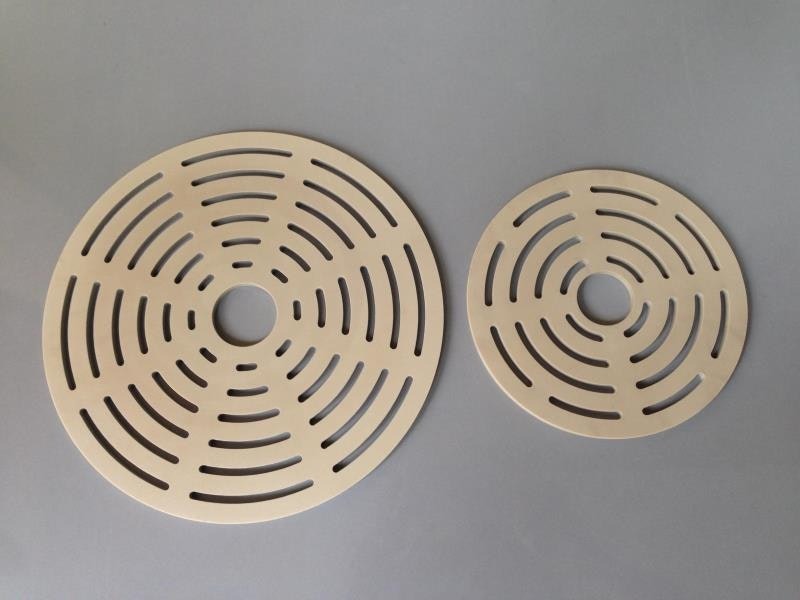News
A2025-11-05

PEEK (Polyetheretherketone) is a semi-crystalline thermoplastic engineering plastic. Its unique molecular structure grants it outstanding comprehensive properties, making it an ideal material for replacing metal valve plates:
Mechanical Properties
Tensile Strength: 90-100 MPa
Flexural Modulus: 3.8-4.5 GPa
Impact Toughness: No breakage in notched impact tests
Thermal Properties
Continuous Service Temperature: 250°C
Short-Term Temperature Resistance: Up to 300°C
Glass Transition Temperature: 143°C
Chemical Stability
Acid and Alkali Resistance Range: pH 0-14
Solvent Resistance: Resistant to most organic solvents
Hydrolytic Stability: Stable performance in high-temperature steam
Lightweight Design
Density only 1.3 g/cm³, approximately 85% lighter than stainless steel
Reduces inertial forces, improves valve response speed
Reduces wear on moving parts, extends service life
Exceptional Fatigue Durability
Fatigue life is 5-8 times that of metal valve plates
Can withstand over 10^7 open-close cycles
Maintains stable sealing performance under pulsating conditions
Self-Lubricating Properties
Low friction coefficient (0.1-0.3)
Can operate normally under oil-free lubrication conditions
Reduces wear on sealing surfaces, increases seal life
Corrosion Resistance
Resists corrosion from most acid, alkali, and salt solutions
Does not suffer from stress corrosion cracking in chloride environments
Suitable for corrosive media in chemical, pharmaceutical industries, etc.
Compressor Industry
Oil-free air compressor valve plates: Ensure outlet air quality
High-pressure compressors: Reduce impact vibration and noise
Corrosion-resistant compressors: Handle acidic or corrosive gases
Petrochemical Industry
Corrosion-resistant valves: Handle sour crude oil and corrosive media
High-temperature valves: Stable operation in hot oil systems
Metering pump valve plates: Ensure precise flow control
Pharmaceutical and Food Industries
Sanitary-grade valves: Comply with FDA certification requirements
Sterile systems: Withstand steam sterilization
High-purity systems: Do not contaminate media, easy to clean
Special Applications
Deep-sea equipment: Corrosion-resistant in seawater, lightweight
Aerospace: Meets lightweight and reliability requirements
Hydrogen energy systems: Resistant to hydrogen embrittlement, good safety
Structural Design Optimization
Use Finite Element Analysis (FEA) to optimize stress distribution
Design appropriate preload to prevent fluttering
Consider the effects of differences in thermal expansion coefficients
Molding Process Control
Injection Molding Temperature: 360-400°C
Mold Temperature: 160-180°C
Annealing: Relieves internal stresses, improves dimensional stability
Surface Treatment Technology
Plasma treatment to improve surface wettability
Special coatings to further enhance wear resistance
Precision machining to ensure flatness of the sealing surface
Consideration of Operating Parameters
Medium Temperature: Determines risk of thermal deformation
Working Pressure: Evaluates creep resistance
Cycling Frequency: Considers fatigue life
Medium Characteristics: Confirms chemical compatibility
Material Grade Selection
Virgin PEEK: For general conditions, cost-effective
Carbon Fiber Reinforced: Higher stiffness and wear resistance
Graphite Filled: Improved self-lubricating properties
Glass Fiber Reinforced: Balanced strength and cost
Installation Precautions
Ensure valve seat sealing surface roughness Ra ≤ 0.8 μm
Control bolt torque to avoid over-tightening
Check guide part clearances to prevent jamming
Operational Monitoring Points
Regularly check valve plate thickness wear
Monitor valve opening/closing noise changes
Record operating hours to predict maintenance cycles
Failure Warning Indicators
Sealing performance degradation exceeding 20%
Thickness wear reaching 10% of original size
Visible cracks or permanent deformation
Composite Material Innovation
Nanofiller reinforcement: Improve mechanical properties
Oriented fiber alignment: Optimize anisotropy
Multifunctional composites: Impart conductive/thermal properties
Smart Manufacturing Technologies
3D printing for integrated manufacturing of complex structures
Digital twin technology for optimized service life prediction
Intelligent monitoring for predictive maintenance
Sustainable Development
R&D in bio-based PEEK materials
Breakthroughs in recycling technologies
Reducing the carbon footprint throughout the lifecycle
PEEK valve plates, leveraging their excellent comprehensive properties, are redefining the technical standards in the fluid control field. Their lightweight, corrosion-resistant, and long-life characteristics provide equipment manufacturers with superior technical solutions. With continuous advancements in materials science and manufacturing processes, PEEK valve plates will play a key role in a wider range of industrial applications, contributing significantly to industrial upgrading, energy saving, and emission reduction. When selecting PEEK valve plates, it is recommended to collaborate deeply with professional suppliers for personalized design and selection based on specific operational requirements to fully utilize their technical advantages.
[DLSEALS kindly Reminder] Sealing issues? Turn to DLSEALS! As a sealing component manufacturer, we specialize in customizing sealing components, providing a full range of services from design, research and development, production, testing, and more. If you have more information you'd like to know, feel free to contact us directly. DLSEALS's product experts are dedicated to serving you!